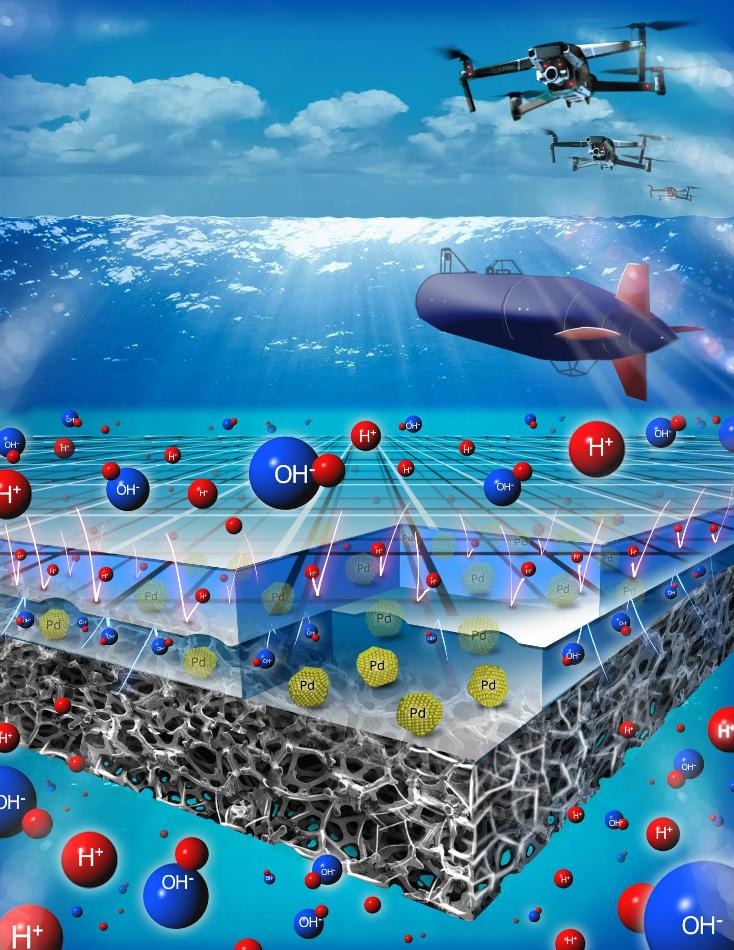Feb 26 2019
In the United States, transportation industry consumes more energy due to increasing demands to make it cleaner and more efficient. Although many people are using electric cars, developing electric-powered ships, planes, and submarines is very difficult due to energy and power requirements.
 An artistic representation of the pH-gradient enabled microscale bipolar interface (PMBI) created by Vijay Ramani and his lab. (Image credit: Washington University in St. Louis)
An artistic representation of the pH-gradient enabled microscale bipolar interface (PMBI) created by Vijay Ramani and his lab. (Image credit: Washington University in St. Louis)
A research team from the McKelvey School of Engineering at Washington University in St. Louis has created a high-power fuel cell that offers technology advances in this area. The team led by Vijay Ramani, the Roma B. and Raymond H. Wittcoff Distinguished University Professor, has designed a direct borohydride fuel cell that works at a voltage twice that of the existing commercial fuel cells.
This development, which involves employing a specialized pH-gradient-enabled microscale bipolar interface (PMBI), has the ability to power a range of transportation modes—such as drones, electric aircraft, and unmanned underwater vehicles—at a notably lower cost. The study has been published in Nature Energy.
The pH-gradient-enabled microscale bipolar interface is at the heart of this technology. It allows us to run this fuel cell with liquid reactants and products in submersibles, in which neutral buoyancy is critical, while also letting us apply it in higher-power applications such as drone flight.
Vijay Ramani, Roma B. and Raymond H. Wittcoff Distinguished University Professor, Washington University in St. Louis
An acidic electrolyte is used at one electrode and an alkaline electrolyte at the other electrode in the newly developed fuel cell. Usually, both the acid and the alkali react rapidly as they approach each other. According to Ramani, PMBI is the major breakthrough, which is very thin when compared to a strand of human hair. The PMBI has the potential to prevent the mixing of the acid and the alkali using the membrane technology developed at the McKelvey Engineering School, thereby forming a sharp pH gradient and facilitating efficient working of this system.
Previous attempts to achieve this kind of acid-alkali separation were not able to synthesize and fully characterize the pH gradient across the PMBI. Using a novel electrode design in conjunction with electroanalytical techniques, we were able to unequivocally show that the acid and alkali remain separated.
Shrihari Sankarasubramanian, Washington University in St. Louis
Once the PBMI synthesized using our novel membranes was proven to work effectively, we optimized the fuel cell device and identified the best operating conditions to achieve a high-performance fuel cell. It has been a tremendously challenging and rewarding pathway to developing the new ion-exchange membranes that has enabled the PMBI.
Zhongyang Wang, Lead Author, Washington University in St. Louis
Wang is a doctoral candidate in Ramani’s lab.
This is a very promising technology, and we are now ready to move on to scaling it up for applications in both submersibles and drones.
Ramani, Roma B. and Raymond H. Wittcoff Distinguished University Professor, Washington University in St. Louis
Cheng He, a doctoral candidate, and Javier Parrondo, a former research scientist in Ramani’s lab, are other participants of this study. The team in collaboration with the university’s Office of Technology Management explores commercialization opportunities.
This study received funding from the Office of Naval Research (ONR; Grant No. N00014-16-1-2833), Washington University in St. Louis, and the Institute of Materials Science & Engineering at Washington University in St. Louis.